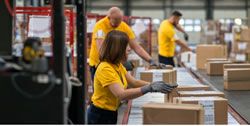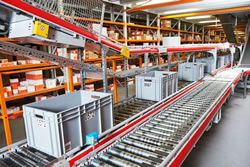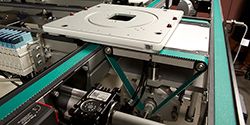How Parvalux Is Helping to Develop the Next Generation of Conveyor Systems
Conveyor systems are central to most warehouse operations, and without regular maintenance, downtime can prevent a warehouse from functioning which obviously has a large financial impact.
The Role of Conveyor Systems in Warehouse Logistics
In many warehouses there is still a reliance on manual labour and heavy lifting which can put workers at risk, as well as compromise on efficiency. This is where conveyor systems can completely revolutionise a warehouse operation.
Case Study from NORD DRIVESYSTEMS - A Better Conveyor
OCC Systems is making automotive assembly lines safer, more energy-efficient, easier to maintain, and less expensive to operate
Outbound Distribution Center
A brand-new outbound distribution facility needed to be equipped with a solution that would provide flexibility, improve productivity metrics, and meet expected quality and durability.
Automation Design Tips: Transferring with Rollers
As technology advances, components become smaller and more compact which requires specific automation techniques and maintenance. Transfer mechanisms require high versatility in its capabilities.
Can You Complete Your Project Without A Conveyor? The Pros and Cons
Can you accomplish the same goals with alternatives to conveyor? Possibly - but consider the opportunity cost. Lets explore some common misconceptions about conveyors, as well as some pros and cons of conveyor alternatives.
Trends in Conveyor Systems and Technology
Conveyors today are built to your specifications to improve efficiency and output of your production line. Theres no reason to settle for a conveyor thats being shoe-horned into your application
Beyond Conveyors: Conveying a Quality Solution
Designing the optimal material handling systems requires a deep understanding of the product, process, and challenges inherent in the manufacturing process.
Records 1 to 8 of 8
Featured Product

MOTION CONTROLLERS FOR MINIATURE DRIVES AND MICRODRIVES
FAULHABER has added another extremely compact Motion Controller without housing to its product range. The new Motion Controller is ideal for integration in equipment manufacturing and medical technology applications. With 36 V and 3 A (peak current 9 A), it covers the power range up to approx. 100 W and is suitable for DC-motors with encoder, brushless drives or linear motors.
Manufacturing and Automation - Featured Company

OnLogic
OnLogic is a global industrial computer manufacturer who designs highly-configurable, solution-focused computers engineered for reliability at the IoT edge. Their systems operate in the world's harshest environments, empowering customers to solve their most complex computing challenges, no matter their industry. OnLogic has helped more than 70,000 customers worldwide advance their ideas with computers that are designed to last, built to order and delivered in days.








